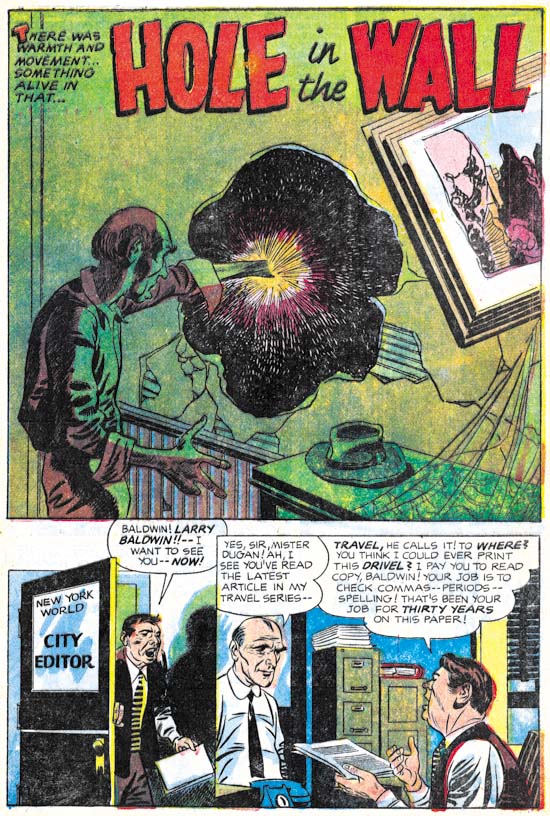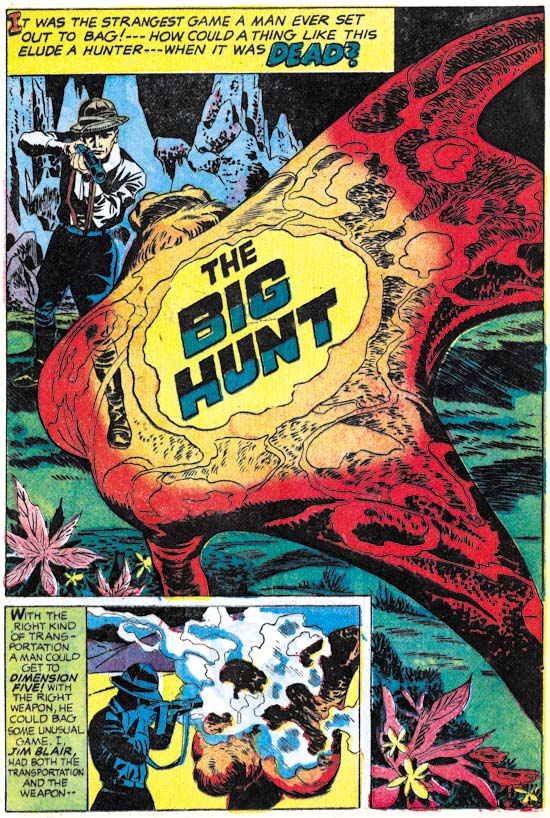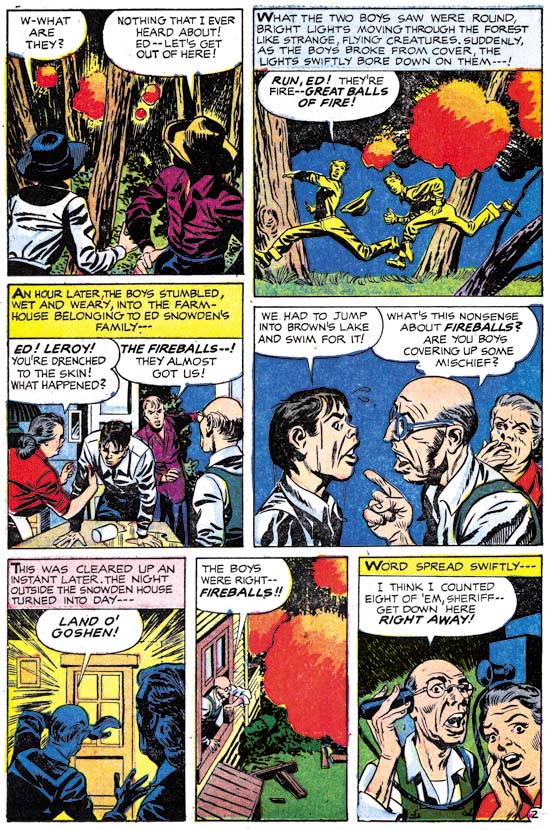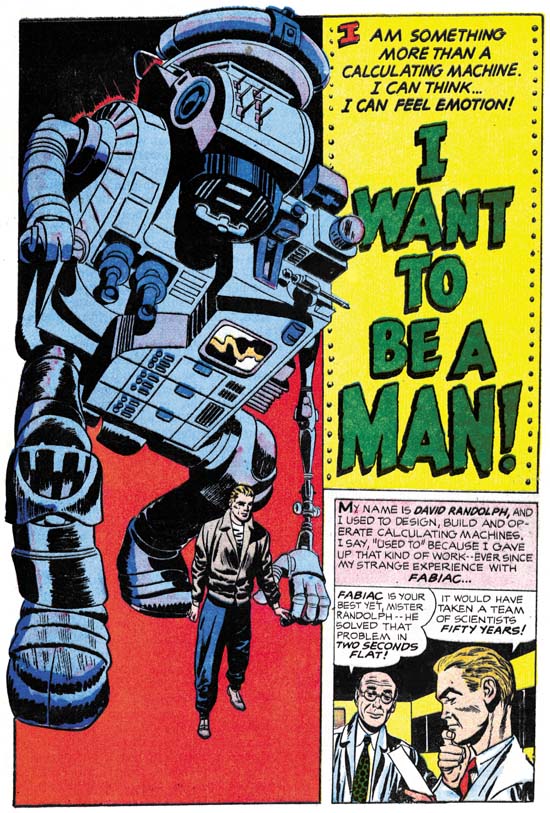
Alarming Tales #2 (November 1957), pencils by Joe Simon
I have discussed this cover on at least three prior occasions. I still feel that my last assessment of the cover art is correct, that is it was drawn by Joe Simon. The large figure looks as though it was done by Mort Meskin but this is easily explained as Joe swiped it from a story that Meskin drew.
While there is a lot of Jack Kirby in this issue, it is technically not an all Kirby comic book as it includes one two page story by Marvin Stein. But the main reason that AT #2 is not as desirable a comic as Alarming Tales #1 or Black Cat Mystic #58 or #59 is the inking which is just not quite as good as those other issues.

Alarming Tales #2 (November 1957) “Hole In The Wall”, pencils by Jack Kirby
This is another story of dimensional travel (Jack Kirby’s Trips to the Fourth Dimension). Only this time there is no explanation of how the “hole in the wall” came to be. Further the other dimension turns out to be a rather nice place to live.

Alarming Tales #2 (November 1957) “The Hero”, pencils and inks by Marvin Stein
Marvin Stein entered the advertisement field sometime in 1958 (Commercial Work by Marvin Stein) so this work from AT #2 is from near the end of his comic book career. Actually that is not completely accurate because Stein continued to provides some comic book art up to June 1959. Stein’s late style was simple but done with great assurance. I am not sure how he went about creating his story art but his covers were first very roughly drawn with a blue pencil, really nothing more than quick layouts. Marvin would then add details and finish the drawing not in pencil but directly in ink. It is a procedure that very few comic book artists adopted. Stein inked his own art with a very blunt brush but this was by choice. Marvin did some inking for DC on Superboy adhering to the house style with a finer brush. His ability to do quality inking with fine detail can be seen in the inking he did for Jack Kirby in syndication proposal called Space Busters (Bleeding Cool or What If Kirby).
This very short (two pages) story is about the exciting adventurous life of a spaceman. But not everyone could be a spaceman, you had to be very special. Special in this case is of a very small stature. Jack Kirby would take this same theme for one of the story lines he used in Sky Masters (a syndication strip that debuted on September 8, 1958).

Alarming Tales #2 (November 1957) “The Big Hunt”, pencils by Jack Kirby
Another story of dimensional travel, in this case to dimension five. I find it humorous that a scientist would hire a big game hunter to test his device. Or that the hunter would return without anything from the new dimension. Big game hunters was imposing figures in the culture of the time. A lone individual faced against dangerous prey exemplified bravery. But with today’s the threat of mass extinction, big game hunting seems out of place. Most people would prefer to see a wildlife documentary than some trophy hanging on a wall.

Alarming Tales #2 (November 1957) “The Fireballs” page 2, pencils by Jack Kirby, inks by George Roussos with some touchups by Kirby
“The Fireballs” is the story featured on the cover although in the story there is no monster like figure associated with the fireballs. Such deviations of the cover from the story are not that unusual for Simon and Kirby, or comics books in general at that time.
Previously I had considered this story as inked by Kirby as well. That was based on the inking found in certain sections. Notice the inking on the elderly man’s sleeve in panel 4 of page 2. This type of inking I refer to as picket fence inking (Inking Glossary). The manner that its done, drop strings with penned pickets is typical of Kirby’s inking at this time. I am still very much convinced that Kirby inked this particular piece and some other found in this story.
However inking done on Kirby pencils was often done by more than one individual. At one time inking was often done like an assembly line with different inkers working on different aspects of the same pages. With the end of the Simon and Kirby studio such assembly line inking was no longer used but it was still very common for someone to ink Kirby’s pencils and then Jack would go over it providing touch-ups. That is what happened in the inking of “The Fireballs”. The more simplified eyebrows, use of crosshatching by pen, the rather rush looking to the work, and the common use of lighting directed up from below all remind me of the work of George Roussos to whom I now credit with the majority of the inking of this story.

Alarming Tales #2 (November 1957) “I Want To Be a Man”, pencils by Jack Kirby
Robots appeared relatively frequently in Kirby stories during this period (Year of the Robots). I have no good explanation for this. Yes robots appeared in various science fiction movies but none quite like the type of robots that Kirby created. His as large and distinctly mechanical. The one in “I Want to be a Man” is filled with mechanical forms. Throughout his career Kirby had a love of what I call Techno Art (Some Early Jack Kirby Techno Art). Such art would include a multitude of shapes and devices that serve no purpose other than to suggest advanced technology.

